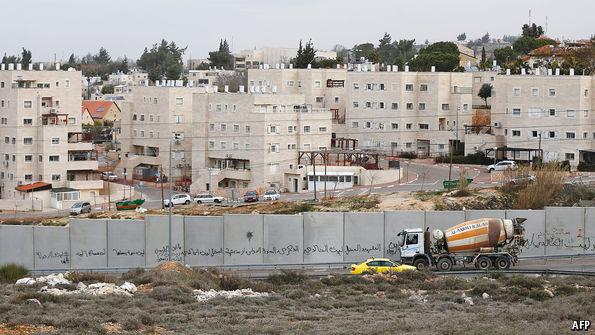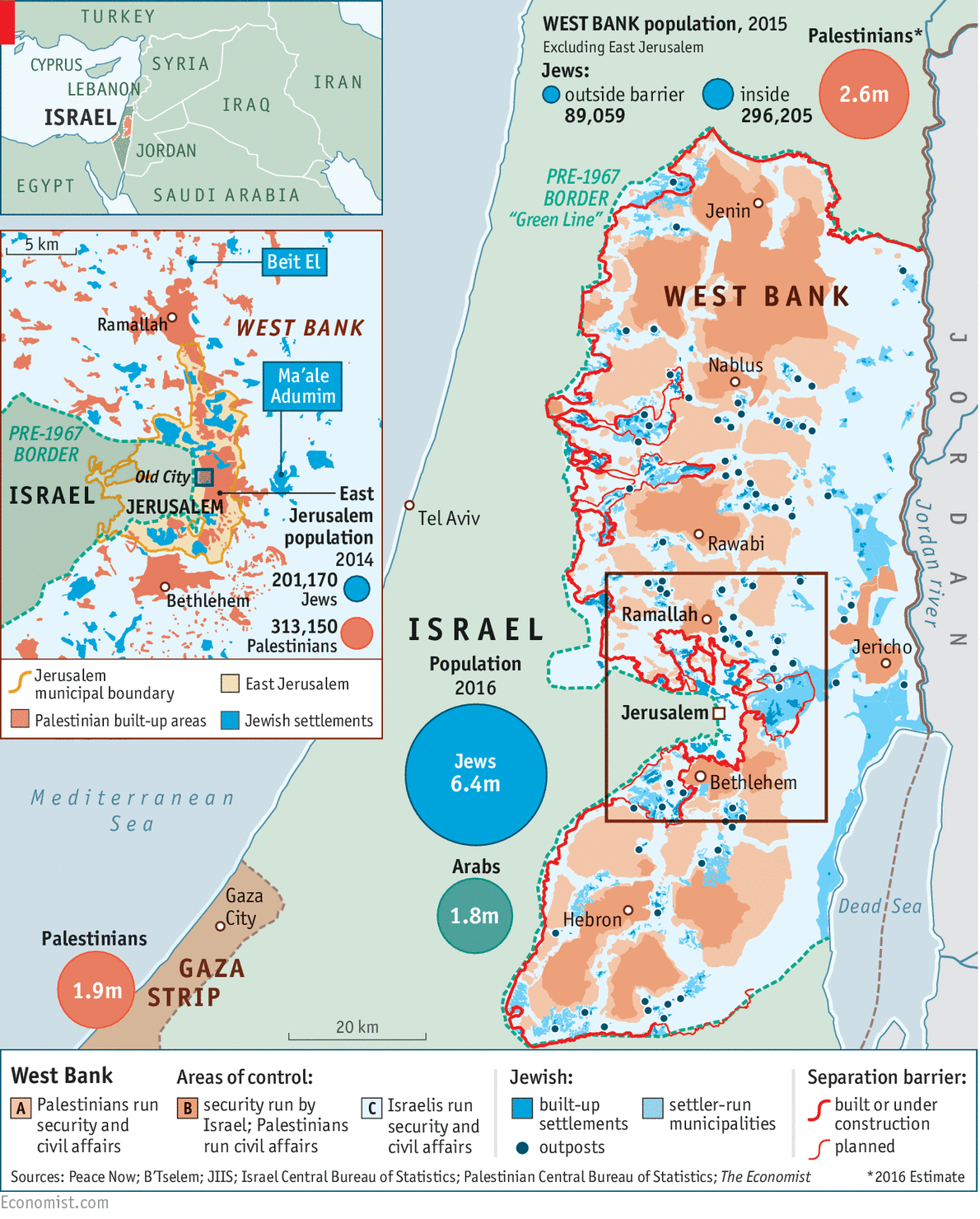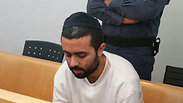Poikkeuksellisen neutraali artikkeli
The Economistilta Netanyahun Washingtonin vierailun alla:
The ultimate fantasy: As Binyamin Netanyahu prepares to fly to Washington, is the two-state solution dead?
The chances for peace were thin even before Donald Trump’s election; they now look even thinner
From the print edition | Middle East and Africa
Feb 11th 2017 | JERUSALEM
THE settlement of Beit El (pictured) sits on a lonely hilltop deep inside the West Bank, between the river Jordan and the Green Line that divided Israel from its Arab foes after a ceasefire in 1949. Built on private land seized by the Israeli army in the name of security in 1970 but soon made available for settlement by Israeli civilians, it has grown into a community of 6,500 people, including 350 students at its
yeshiva (Jewish religious academy). What is left of an old perimeter fence stands rusting; a new one, drawn much wider, surrounds a larger and still growing Beit El.
Under any plausible peace deal between Israel and the Palestinians, Beit El would have to be cleared. It lies outside not just the Green Line but well beyond the separation barrier, part towering wall and part fence, that Israel has been building since 2002. Most observers reckon that the barrier will become the border if peace is ever agreed. It runs mostly along the Green Line, but in several places makes deep salients into the West Bank.
Donald Trump has called peace between Israel and Palestine the “ultimate deal”. He has asked his son-in-law, Jared Kushner, to work on it. But as Binyamin Netanyahu, Israel’s prime minister, prepares to fly to Washington to meet the president on February 15th, peace seems farther off than ever. Since Mr Trump’s inauguration, Mr Netanyahu’s government has approved 6,000 new homes in existing settlements in the West Bank and East Jerusalem. On February 6th, the Knesset passed a law legalising in some cases settlers’ homes illegally built on private Palestinian property.
Mr Trump, so the builders reckon, looks unlikely to put much pressure on Israel to hold back. Indeed, he gave $10,000 to Beit El in 2003. His proposed new ambassador to Israel, David Friedman, is president of the American Friends of Beit El Yeshiva association. Israel’s settlers could not wish for a more sympathetic envoy, or a more sympathetic president. The occupation of the West Bank is 50 years old in June, and shows no sign of ending.
The Great Cunctator
That suits the cautious Mr Netanyahu well. His strategy for the past eight years has been to do nothing: to go on paying a degree of lip-service to the idea of the “two-state solution” agreed in outline by Israelis and Palestinians at Oslo in 1993 (with the difficult details left for later), but not to make any actual progress towards it.
The appetite for peace in Israel is constrained by fear, which Mr Netanyahu exploited to help win his fourth election in 2015. Recent opinion polls still put his centre-right coalition well ahead of the disunited opposition. The latest wave of violence, what some call the “knife
intifada”, started in October 2015. By the time it fizzled out last summer, 38 Israelis and 235 Palestinians had died. And the murders have not entirely stopped. Last month a suicidal assailant drove a lorry into a group of Israeli soldiers in Jerusalem, killing four of them.
The Palestinians’ government has an awful record of glorifying terrorism. Its president said of the knife
intifada that every drop of blood spilled in Jerusalem was “pure”. One of his possible successors called the attackers heroes. In the previous
intifada of 2000-05, more than 1,000 Israelis (and 3,000 Palestinians) died.
The disasters that have followed the Arab spring of 2011 have reminded Israelis that Arab regimes are fragile and unpredictable. Libya, Syria and Yemen are collapsed states; Jordan and Egypt are stable, but not reliably so. However, it is Gaza’s recent history that worries them most.
In 2005 Israel withdrew from Gaza, a strip of land twice the size of Washington, DC, with three times the population and not many jobs. Hamas, a radical Islamist group, took over. It supports attacks on Israelis, does not recognise Israel’s right to exist and has never signed up to the Oslo agreements. This stance, and a reputation for being less corrupt than the more moderate Fatah faction, helped it to win a Palestinian election the following year. It then chased Fatah MPs out of Gaza.
Since then Gaza, impoverished by a tight Israeli blockade and frequent incursions (not to mention Hamas’s mismanagement), has continued to pepper Israel with home-made rockets, most recently this week. A network of tunnels has been used not just to smuggle but to infiltrate Israel and kidnap Jews.
To Naftali Bennett, who leads the pro-settler Jewish Home party in Mr Netanyahu’s coalition government, the lesson of Gaza is that the two-state solution cannot work. “There is no way that I am ever going to allow a Muslim state to be created on my mountains, looking down at my airport and my capital,” he says. The secular face of his party, the justice minister Ayelet Shaked, agrees. “More peace talks meet Einstein’s definition of insanity,” she says. “Doing the same thing over and over again, and expecting a different outcome.” Mr Netanyahu has derided a future West Bank state as “Hamastan B”. During the campaign in 2015 he said that Palestinian statehood would not happen on his watch.
One reason so little has changed is that no one has pushed Mr Netanyahu very hard to make peace. Even Barack Obama, whose distaste for him was obvious, never put Israel under great pressure. Last year America concluded a new ten-year defence deal at the record level of $38bn. Even December’s critical UN Security Council resolution merely restated past policy. Sticks that might have hurt Israel, such as the recognition of Palestine as a full member of the UN, or a UN demand for a two-state solution within a mandated time-limit, have not been wielded, and seem most unlikely to be under Mr Trump.
Mr Netanyahu has improved Israel’s relations with Russia and China. Egypt and the Gulf states are also quietly friendly: they share his hostility towards Iran, and are more interested in thwarting it than in helping the Palestinians. He has restored diplomatic ties with Turkey, in the past a firm supporter of Hamas. The BDS movement (Boycott, Divestment, Sanctions) generates noise but no pain; foreign investment in Israel is three times higher than in 2005, when the campaign began.
West Bank paralysis
Mr Netanyahu has an accomplice in preserving this state of affairs: Mahmoud Abbas, the president of the Palestinian Authority, who rules the West Bank from his fortress-like compound, the Muqata, in Ramallah. The 81-year-old Mr Abbas is in a spectacularly weak position. He has just started the 13th year of his four-year term. He was elected in January 2005; since then the break with Hamas has made it impossible to conduct either presidential or parliamentary elections in Gaza. So he lingers on, without a democratic mandate, presiding over only the West Bank. Should an election be held, polls predict that Hamas’s probable candidate, Ismail Haniyeh, a dynamic 54, would beat him.
The corrupt and poorly managed Authority is wholly dependent on Israel. Most of its revenues come from customs duties, collected by Israel since it controls the seaports, airports and land crossings through which goods destined for the West Bank must travel. Israel can cut those off at any time, and in the past has done so.
How long will it last?
At least 100,000 Palestinians commute daily from the West Bank to work in Israel, half with permits, the rest smuggled in. Another 50,000 or so work in Israel’s 130 settlements, many of them building new houses for the next wave of settlers. With 26% unemployment and an employed workforce that numbers not much above 1m, these are big numbers, and Mr Abbas knows that a break with Israel would wreck his economy.
Crucial to him, too, is security co-operation with Israel. Although the PA is supposed to run security inside the Oslo-defined “Area A”, comprising the main West Bank cities, Israeli forces routinely enter them to grab suspected terrorists, including Hamas operatives. This protects the lives of Mr Abbas and his officials, as well as those of Israelis. A return to full-scale
intifada looks unlikely for these reasons, and also because the Israelis have got much better at detecting enemies. Social media and electronic snooping make it easier to keep track of jihadists. “We go after the infrastructure: those who supply the weapons, the cars, the inciters,” explains an army major at Judea and Samaria Divisional headquarters, in the West Bank.
So Mr Abbas has nothing to gain by ending co-operation with Israel. But neither can he make the concessions that might lead to peace. These would be horribly painful: accepting the barrier as a new border (with some compensating Israeli land returned); allowing a permanent Israeli military presence in the West Bank; giving up the “right of return” for refugees who fled in 1948 and 1967. Palestinian public opinion is passionately against such concessions to an Israel they mistrust. Hamas would probably resist them violently.
A deal on such terms would not be considered fair by many people or governments outside Israel either. Yet the harsh reality is that it is the only one Israel is likely to offer, since it is so much stronger than the Palestinians and feels so little need to compromise. Even talking about such a deal hurts Mr Abbas and boosts Hamas. It is much easier for him to stall.
At a crossroads
Politicians as far apart as Mr Bennett and Tzipi Livni, a former foreign minister and a leader of the Zionist Union, a left-of-centre parliamentary group, do not agree on much. But both argue that the stasis that has marked Mr Netanyahu’s reign could now change. With Mr Trump in the White House, a big constraint on Israeli action—the fear of American condemnation and UN action—seems to have gone. “This is the first time in 50 years that Israel has to decide what it wants to do,” says Mr Bennett. Ms Livni echoes him: “We are at a crossroads; there are two visions for our future; a two-state solution, or a Greater Israel.”
By withdrawing his eight Jewish Home MPs from the ruling coalition, which has a majority of only six, Mr Bennett could bring it down at any time. That could trigger an election, which the polls say would see him take several seats from Mr Netanyahu’s Likud. Eager to avoid this fate, and weakened by a police investigation for corruption, Mr Netanyahu risks being dragged ever further to the right by Mr Bennett. As well as authorising the building of 6,000 new homes in the settlements so far this year, last week he promised settlers evicted from an unauthorised settlement that he would provide a new, recognised one.
How long will it last
Mr Bennett makes no secret of what he wants: the annexation of all of Area C, comprising 61% of the entire West Bank. As well as the roughly 200,000 Israelis who live in East Jerusalem (annexed in 1967 by Israel, though no other country accepts this), Area C is home to almost 380,000 Israelis, but only around 150,000 Palestinians. They are hampered by the Israeli occupation when they try to build, or run businesses, or move about; 3G telephony on Palestinian networks, despite Israeli promises, has not materialised. Their slender numbers, though, mean that Israel could in theory annex Area C without threatening Israel’s Jewish majority, even in the long term. Currently, there are about 6.4m Jews in Israel (the official number includes those in East Jerusalem and the West Bank) and 1.8m Arabs.
Annexing all of the West Bank would be another matter. There are about 2.6m Palestinians there, besides the 313,000 in East Jerusalem. Israel would have to decide whether to grant them political rights, which would alter the composition of the country completely and forever. The other option would be something like the old South African apartheid. No mainstream Israeli politician supports this, though plenty of zealots do.
Mr Bennett is still part of a small minority. And even he aims to achieve his goal only in steps. His first aim is to take in Ma’ale Adumin, a large settlement of some 40,000 people five miles east of Jerusalem. Mr Bennett picked it to be provocative, since it is both big and well into the West Bank, though within a still-uncompleted salient of the separation barrier.
However, it is not clear that he has enough support to get the ruling coalition to approve his proposed annexation bill. Nor is it clear that he would bring down the government if he fails. Mr Netanyahu, ever cautious, has so far managed to persuade the coalition to avoid taking a decision until after he has seen the American president, and will probably urge Mr Trump to oppose it. But if Mr Trump were to signal approval, the annexation of Ma’ale Adumin could swiftly pass. Other settlements within the barrier might follow.
Annexation beyond the barrier would be a much more dangerous move, creating the Greater Israel that Ms Livni has warned against and making any future peace deal much harder, if not impossible. It also risks triggering a violent reaction. Yet that does not mean it will not happen. This week’s decision by the Knesset to, in effect, legalise certain land seizures in the West Bank, some of them well beyond the barrier, is a step in that direction.
You go your way and I’ll go mine
There is another way that the future could unfold. The two largest parties on the centre-left are Labour and Yesh Atid, the personal vehicle of a former TV chat-show host, Yair Lapid. Both favour a complete separation between Israel and the Palestinians: a detailed Labour plan suggests falling back to the separation barrier and bringing all that territory into Israel. They would then aim to negotiate security arrangements for the West Bank with regional Arab powers and with the Palestinians themselves.
Where all such plans falter is over security. To the Palestinians, any deal that does not nail down a final departure date for Israeli troops is not compatible with sovereignty. But until there is a new Middle East, it is hard to see any Israeli prime minister providing such a pledge. Trusting the UN, or the Americans after their experience with Mr Obama, let alone a pan-Arab force, would look too risky.
The left is not in any position to put its plan into action. But politics in Israel is subject to sudden realignments: when he was prime minister in 2005 Ariel Sharon abruptly left Likud to set up a new party, Kadima, which led a new ruling coalition. Likud might fracture in the months ahead. Mr Netanyahu would like to bring Labour into his coalition, and its struggling leader, Isaac Herzog, might even agree. He could then be shot of Mr Bennett, and might explore a separation deal.
Or, if Mr Netanyahu were forced to resign following an indictment arising from his corruption probes, Mr Lapid or Mr Herzog might piece together a centre-left government. This might come after a snap election and include disenchanted parts of Likud, such as a faction led by a former defence minister, Moshe Yaalon. The new prime minister could then start peace talks, if he dared. A generous package of economic incentives, including rights for Palestinians to build into Area C from the edges of crowded Areas A and B, plus an offer of land swaps, might bring Mr Abbas to the table. But the security issue would remain. Without a solution to it, the Palestinians are unlikely to agree—though some on the Israeli right think they might be persuaded by large dollops of investment.
Might Israel instead impose separation unilaterally, pulling back to the barrier, but continuing to keep its army in the West Bank, and perhaps recognising Palestine? That too seems tricky: there are close to 90,000 Jews living in settlements beyond the barrier. Perhaps half of these might agree to move, if offered homes inside the wall (cheap accommodation is one of the things that makes the settlements attractive). But 40,000-50,000 of the settlers are reckoned to be there for ideological reasons. Moving so many against their will would be very hard; leaving them behind might endanger their lives.
A unilateral move like this, however, would at least end the 50-year-old occupation before yet another generation of young Israelis and Palestinians is brutalised by it. And it could lead to a Palestinian state that the world might then recognise. That would indeed be a two-state solution; but not a stable or a secure one. No one would win Nobel prizes for that.















